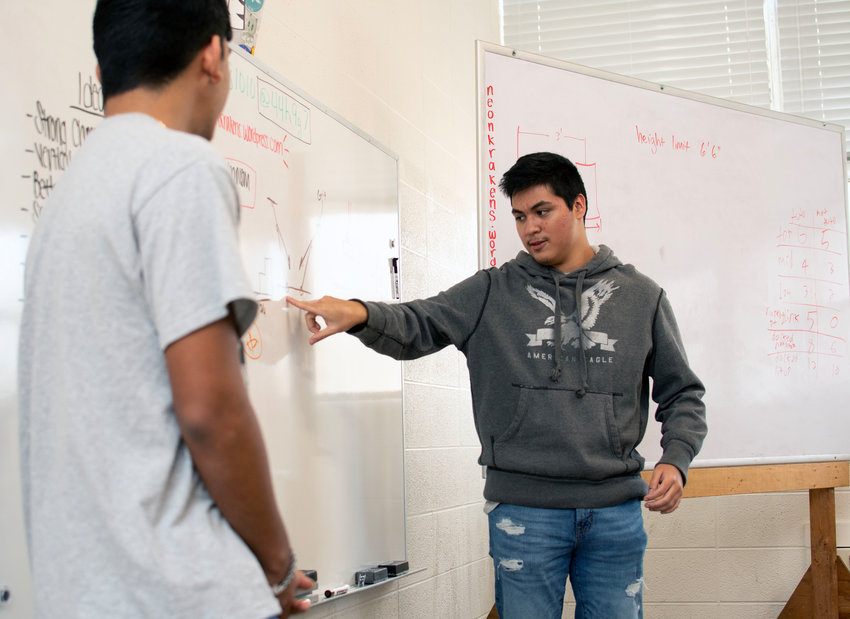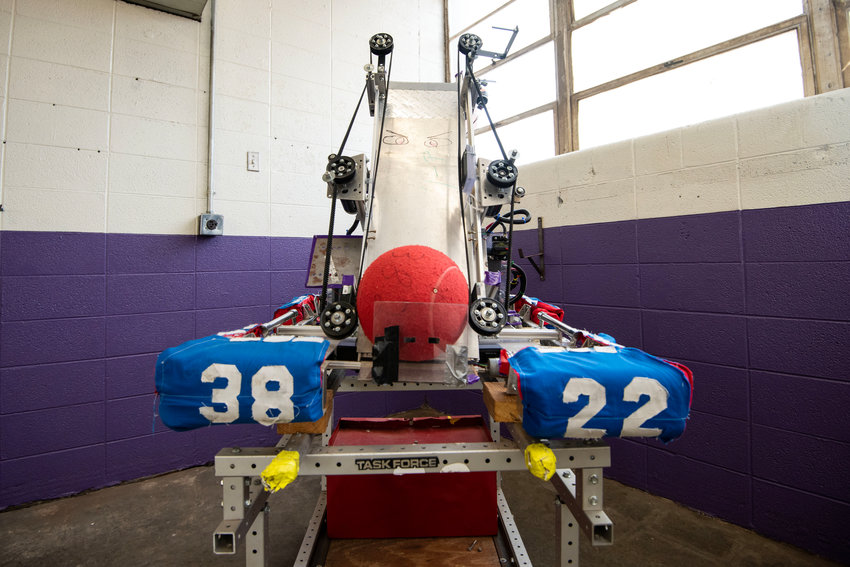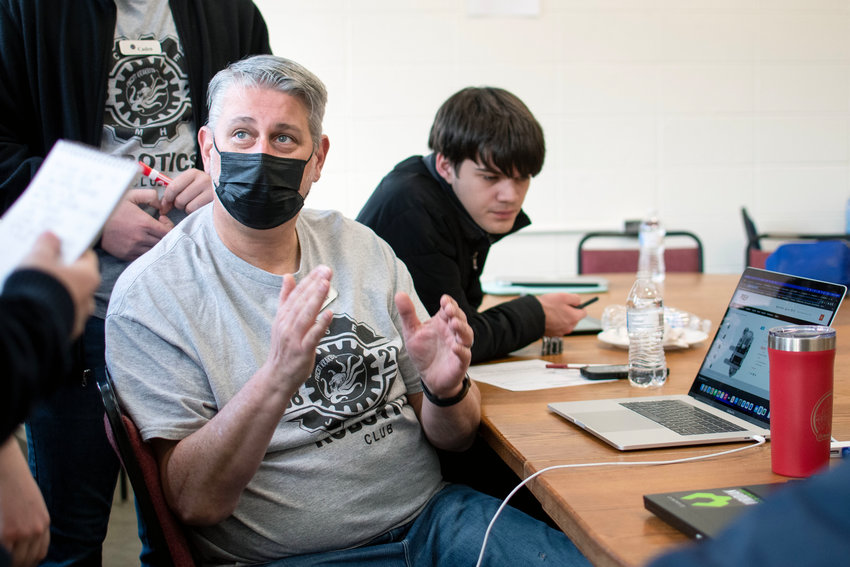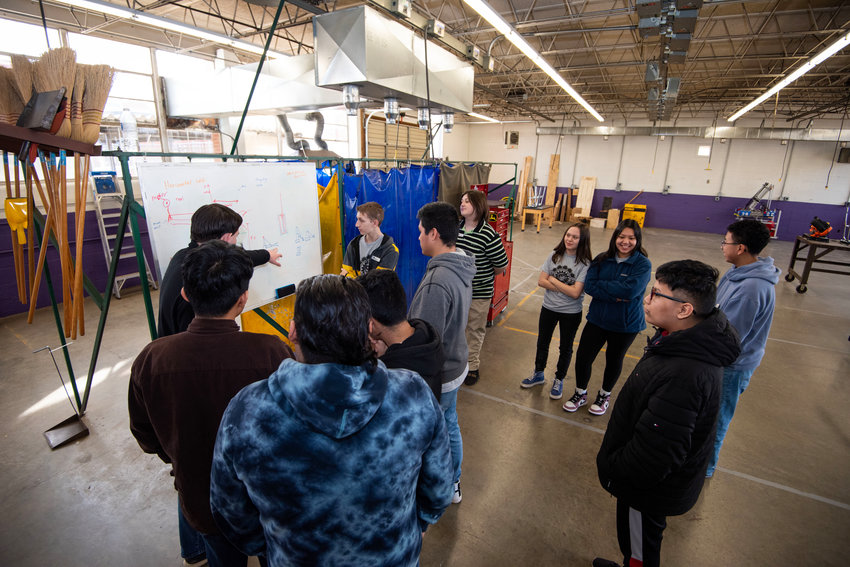![]()
Ben Rappaport, Chatham News + Record
On a Saturday morning in a warehouse next to Chatham School of Science & Engineering, Jordan-Matthews High School Junior Lizbeth Tellez-Canuto is proposing a new idea.
She’s trying to configure the arm of a robot to go both vertically and horizontally without tipping the whole thing over. It’s more complicated than it may seem because that arm has to pick up blocks and cones and place them in precise locations.
Tellez-Canuto proposes bolstering the base of the arm with sturdy materials to ensure the arm can reach the maximum height and length necessary to score points.
“We know we need to make it extend faster than the previous bot,” she says aloud. “What do we think about an elevator-style versus a parallel style?”
The question is posed to a room full of 26 other students, all members of Chatham County’s robotics team, the Neon Krakens.
Tellez-Canuto’s teammate, Emmanuel Hernandez Castaneda, a junior at Jordan-Matthews, writes her ideas on the whiteboard and attempts to draw as she describes her vision. Other students shout out feedback and propose tweaks. It’s a truly collaborative, student-led process that makes the robot from an idea into reality.


The Neon Krakens team is a partnership between the Chatham School of Science & Engineering and Jordan-Matthews — as of now, the only robotics team in Chatham County Schools. Saturday marked the team’s kickoff of the 2023 season, the ninth year of Chatham’s robotics team.
Thinking big
The Neon Krakens are officially registered as a For Inspiration and Recognition of Science and Technology (FIRST) Robotics team. The organization has thousands of teams across 32 countries.
Under strict rules, and with limited time and resources, teams of students are challenged to raise funds, design a team “brand,” hone teamwork skills, and build and program industrial-size robots to play a difficult field game against like-minded competitors. Volunteer professional mentors lend their time and talents to guide each team.
FIRST also hosts annual competitions where schools across the world are all given the same challenge and must build a robot to complete that mission. Each year’s challenge is different from the last. Saturday marked the international launch of the season.
At CSSE, the Neon Krakens eagerly awaited the explanation of the game as they pounded the table in a drum roll.
While it’s complicated to explain in depth, this year’s game involves building a robot that can pick up cones and cubes and place them on different markers on the field. Teams can also score points by balancing their robot on a “charging station.”
As soon as the game is announced, the team wastes no time.
Team captains pull up a copy of the game manual and split the team into small groups — one team on vertical motion, one on horizontal, a third on the claw mechanism; they divide and conquer.
Prior to the FIRST launch, the Neon Krakens had no idea what they were preparing for this season. So proposals and ideas like Tellez-Canuto’s were the starting point for the new bot.

Neon Kraken member Yahir Gonzalez, junior, presents a design concept last Saturday during a team meeting.
“We have a lot of new people this year so we are essentially starting from scratch,” said Jennifer Hawkins, one of the team’s coaches.
But if you ask the Co-Captain Caden Bailey, a sophomore at CSSE, that’s not necessarily a bad thing. To him, it means the members of the team think big about their ideas for the robot and aren’t limited in their creativity.
“Sometimes it’s good to think outside the box and I think we will certainly have that on this year’s team,” Bailey said.
Bailey is in his second year on the team, but his first as co-captain. And thanks to his leadership along with other veterans on the team, he also knows the team isn’t completely in the dark.
Building on the past
Bailey and Luke Hawkins, the lead captain and senior at CSSE, said the bots they built last season taught them important lessons they’ll use for this season, even if the challenges are different.
For example, last year’s bot, nicknamed the Space Invader, had to pick up a ball and launch it into hoops at various heights. While the task is fairly different this year, Luke said the team’s last bot consistently struggled with its mobility because it didn’t put enough motors on the wheels.
“We would see these other teams who were just flying around and could move side to side so much easier than us,” Luke said of last year’s competition. “So we asked them what they were doing and they told us they had a motor for each of the four wheels.”
Essentially, the Neon Krakens were operating in two-wheel drive while their competitors had four-wheel drive.

‘Space Invader,’ a robot built by the Neon Krakens in 2022, sits in the corner of a CCSE workshop during a team meeting last Saturday.
Outside of the main challenge, the team also held a mini-competition last year where they had to pick up blocks and stack them. While their bot, nicknamed Work Bench, struggled in that competition, they learned how to devise a proper claw or grabbing mechanism to better pick up items.
“The mini-bot only had a claw with one mechanical arm,” Luke said. “I’m thinking for this challenge we will need at least two moving pieces of the grabber if not more to make sure we can grab round objects like the cone and the cubes.”
By the end of the Saturday brainstorm, the small groups have come back together and begin pitching their ideas for this year’s bot. Initially, there are some blocks of silence — fears from the new team members that their ideas aren’t practical or won’t make sense. But after some encouragement from Hawkins, coaches and mentors the creative juices start flowing.
“The sooner we nail down an idea, the sooner we can get building and constructing this thing,” said Michael Bailey, a mentor with the team and Caden’s father. “Every session counts, trust me.”

Neon Krakens mentor Michael Bailey talks with students during a team meeting at CCSE last Saturday.
Jennifer Hawkins echoed the sentiment. The team only has until the beginning of March to design, construct and test the robot before it has to enter competition, so every session counts.
She recalls last year’s competition preparations, where the team stayed in the CSSE warehouse until past 11 p.m. the night before competition because the bot still wasn’t finished.
Rust around the edges
The team finished 12th in that competition, and they’re hoping for a higher placement this year — which means making the most of the limited time they have together.
Other schools make their robotics team an entire class period that meets daily, or designate the activity as an official sport so that it’s given priority when scheduling conflicts arise.
Designating robotics as a sport would also mean the coaches could receive a stipend for the hours they pour into their teams.
The Neon Krakens, however, don’t have any of those luxuries because of the mix of schools and transport issues. Their coaches, while they are Chatham County Schools employees, are volunteers and the team only meets twice per week — from 4 p.m. to 6 p.m. after school Tuesdays and again from 10 a.m. to 4 p.m. on Saturdays.
The teams that perform the best are also often from wealthier school districts. All the motors Luke wants to add this year all cost money. In fact, the specific motors for this robot cost $300 a pop. That’s not to mention all the other features required to make the bot successful like gyroscopes, sensors and batteries.
“We would walk into competition last year and see these bots that were like powdered and chrome,” Luke said. “It was like they had professional equipment on this thing.”
The only materials given to each team by FIRST are sheets of aluminum, metal tubing, gears and reflective tape. Everything else comes out of the team’s pocket.
While the team does get sponsorships, including a grant from John Deere, they still occasionally find themselves struggling to get all the materials they need for the robot.
Jennifer Hawkins said the team does not charge membership dues because they want to keep the club as accessible as possible for students of all backgrounds.
The Neon Krakens are currently in search of sponsors and have an Amazon wishlist for the 2023 season; information on both can be found on their website www.neonkrakens.wordpress.com.
More than nuts and bolts
Fundraising is just another skill learned through the robotics club. The Neon Krakens team is composed of more than just wannabe engineers and STEM students. It’s also students with a talent for marketing, social media, fundraising, design and more.
All the efforts of the team are student-led, so even if programming and constructing a robot wasn’t someone’s forté, they can still benefit the team.
Andy De La Cruz Plata, a senior at J-M, is in his first year on the team and assists with fundraising and media. He joined the Neon Krakens because a friend of his encouraged him to come. Even though he had limited interest in robotics, he obliged.
“My friend told me I’d be good for the media side of things,“ he said.
The friend believed his outgoing personality could be used to secure sponsorships and spice up the team’s social media presence.
But during the Saturday brainstorming, De La Cruz Plata wasn’t doing those things. He was drawing a claw-machine-like device as a possibility for the robot to pick up the necessary items from the challenge.
Mentor Michele Bailey said each member of the team plays a role in every other aspect to build “a cohesive unit.”
“They all get excited about various things and carve out a niche in that sub-team,” Bailey said. “But it’s really such a student-led group effort and they collaborate on everything.”
The mentors on the team like Bailey also try to bring in industry professionals in the world of robotics and engineering to show members of the team that the skills they learn here have real-world applications.
From leadership like Luke Hawkins, to public speaking like Lizbeth Tellez-Canuto or fundraising like Andy De La Plata, each member of the team is an important cog in the machine of the Neon Krakens. And it’s their various skills that ensure this year’s robot, whatever it may look like, will be running smoothly.

Neon Krakens members gather in a CCSE workshop to discuss design concepts for the upcoming year.
Chapelboro.com has partnered with the Chatham News + Record in order to bring more Chatham-focused stories to our audience.
The Chatham News + Record is Chatham County’s source for local news and journalism. The Chatham News, established in 1924, and the Chatham Record, founded in 1878, have come together to better serve the Chatham community as the Chatham News + Record. Covering news, business, sports and more, the News + Record is working to strengthen community ties through compelling coverage of life in Chatham County.

